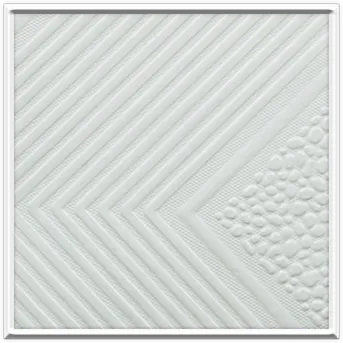Dec . 23, 2024 02:25 Back to list
mineral fiber ceiling specification
Understanding Mineral Fiber Ceiling Specifications
Mineral fiber ceilings are a popular choice in both residential and commercial spaces due to their acoustic properties, fire resistance, and aesthetic versatility. This article aims to provide an overview of mineral fiber ceiling specifications, helping architects, builders, and interior designers make informed decisions.
What is Mineral Fiber Ceiling?
Mineral fiber ceilings consist of tiles or panels made primarily from natural and synthetic mineral fibers. The most common materials used include fiberglass, gypsum, and various types of cellulose. These materials are molded into tiles or planks, which can be suspended in a grid system or installed directly to ceilings for a clean look.
Key Specifications to Consider
1. Acoustic Performance One of the primary reasons for choosing mineral fiber ceilings is their excellent sound-absorbing qualities. The Noise Reduction Coefficient (NRC) is a critical measurement that indicates how much sound is absorbed by a ceiling material. A higher NRC value (typically between 0.6 and 0.95 for mineral fiber ceilings) signifies better sound absorption. For environments where noise control is essential, such as offices, classrooms, or restaurants, opting for a higher NRC rating is advisable.
2. Fire Resistance Fire safety is a crucial consideration in building materials. Mineral fiber ceilings are inherently fire-resistant, thanks to the properties of the materials used. Their fire ratings (Class A, B, or C) reflect their ability to limit fire spread. Class A is the highest rating, indicating the best performance in preventing flame spread. Specifications usually require compliance with standards such as ASTM E84 for surface burning characteristics.
mineral fiber ceiling specification

3. Moisture Resistance In areas prone to humidity, such as kitchens or bathrooms, moisture resistance is vital to prevent mold growth and ensure long-term durability. Many mineral fiber ceilings are treated with moisture-repellent finishes. Check the ASTM D3273 rating to gauge the material's resistance to mold and mildew growth; a higher rating indicates better performance.
4. Thermal Performance Insulating properties are another essential specification. Mineral fiber ceilings can help with energy efficiency by providing thermal insulation. The R-value of a ceiling material determines its effectiveness in resisting heat transfer. For energy-conscious designs, choosing panels with higher R-values can contribute to overall environmental performance.
5. Aesthetics and Design Options Mineral fiber ceilings come in various textures, patterns, and colors, allowing designers to achieve their desired look. Customization options can include different edge designs, finishes, and acoustic properties tailored to a specific application. When specifying mineral fiber ceilings, consider the aesthetic requirements of the space alongside functional attributes.
6. Sustainability As environmental concerns grow, many manufacturers are producing mineral fiber ceilings using recycled materials and sustainable practices. Certifications like Greenguard or LEED can help identify these eco-friendly products. When selecting materials, it’s essential to assess the sustainability credentials of the product to align with green building goals.
7. Installation Considerations The installation process for mineral fiber ceilings can vary depending on the selected system—suspended grid or direct mount. It’s important to follow the manufacturer's installation guidelines to maintain warranty protection and product performance. Preparation for installation should include an assessment of the existing ceiling structure and any necessary adjustments for optimal alignment and support.
Conclusion
When specifying mineral fiber ceilings, it is crucial to consider a combination of factors, including acoustic performance, fire resistance, moisture control, thermal efficiency, aesthetic appeal, and sustainability. Understanding these specifications can greatly enhance the functionality and comfort of a space while contributing to its overall design. By carefully selecting the right mineral fiber ceiling, professionals can create environments that are not only beautiful and efficient but also safe and conducive to productivity.
-
Durable Ceiling T Grid Systems | Easy InstallationNewsAug.29,2025
-
PVC Gypsum Ceiling: Durable, Laminated Tiles for Modern SpacesNewsAug.28,2025
-
Pvc Gypsum Ceiling Is DurableNewsAug.21,2025
-
Mineral Fiber Board Is DurableNewsAug.21,2025
-
Ceiling Tile Clip Reusable DesignNewsAug.21,2025
-
Ceiling T Grid Modular DesignNewsAug.21,2025







